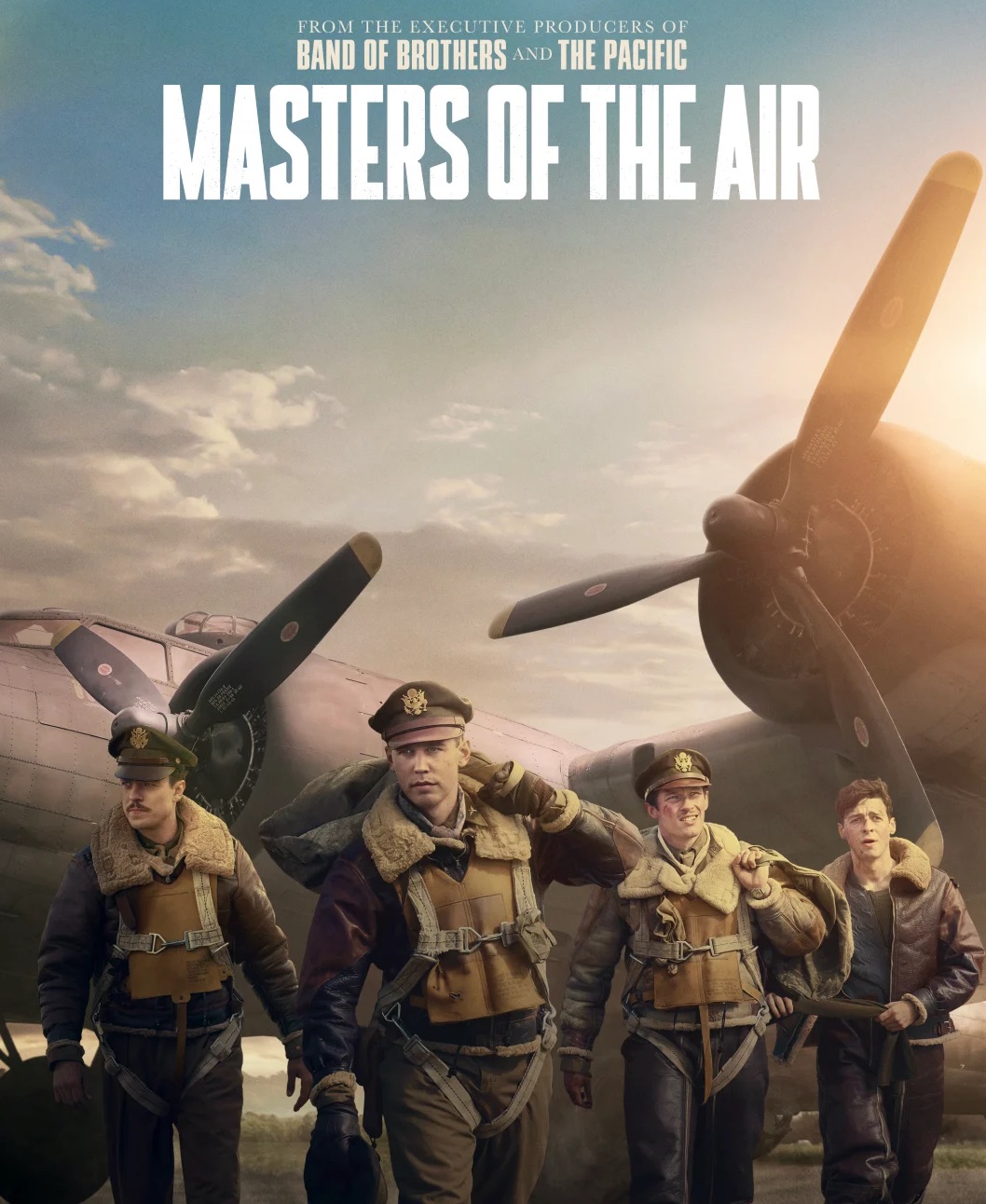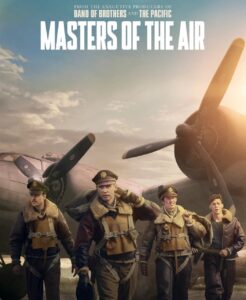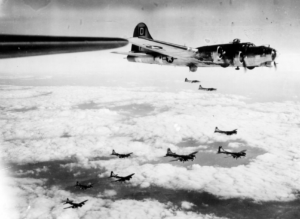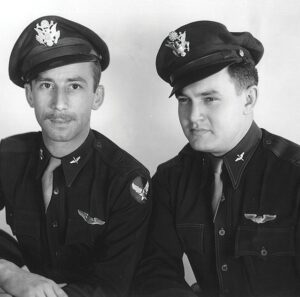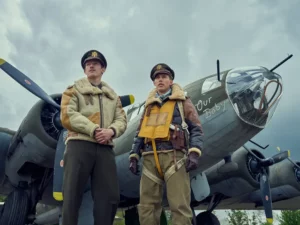Masters of the Air
Films and series on D-Day and the Battle of Normandy
23 years after Band of Brothers and 14 years after The Pacific, Steven Spielberg and Tom Hanks join forces once again to produce a new series dedicated to the history of the Second World War. After a special focus on infantry (both airborne and amphibious), the « Masters of the Air » series focuses on the crews of the U.S. Army Air Force. Like Band of Brothers, which was inspired by historian Steven Ambrose’s book, Masters of the Air is based on Donald L. Miller’s « Master of the Air: America’s Bomber Boys Who Fought the Air War Against Nazi Germany« .
The nine-episode American series will be broadcast from January 2024 on Apple+. In particular, it follows in the footsteps of the 8th U.S. Army Air Force‘s 100th Bombardment Group, a heavy bomber formation equipped with B-17 « Flying Fortresses » that took part in the air campaign for D-Day and the Battle of Normandy, as part of the 13th Bombardment Wing (3rd Bombardment Division) from Thorpe Abbotts air base near the village of Diss in Norfolk, eastern England (where the unit has been operating since June 9, 1943).
Because of the high number of casualties suffered by this formation, it was nicknamed the « Bloody Hundredth ».
B-17 du 100th Bomb Group en formation pendant la Seconde Guerre mondiale.
(NARA)
A few months after their arrival in England, aircraft from the 100th Bomb Group were flying over Normandy. In fact, in the mid-afternoon of October 4, 1943, the B-17 (serial 42-30604) of the 350th Bombardment Squadron returned from a raid in the Frankfurt sector of Germany. Despite dense anti-aircraft cover and the presence of two enemy fighters close to their target, the aircraft was not damaged, but ran out of fuel and the navigator was unable to pinpoint their exact position, as the plane had deviated too far from its planned route.
The crew is then forced to attempt an emergency landing: believing they have reached England, tracer bullets grazing the wings remind the ten men on board that they are flying over enemy territory. The pilot and co-pilot, Captain Harold B. Helstrom and Flying Officer Hubert E. Trent respectively, managed to land the B-17 in the Amayé-sur-Seulles area: immediately after the successful landing, the crew proceeded to neutralize the sensitive equipment, then attempted to set fire to the bomber, while several French civilians came to meet the Americans. The Normans provided details of the Americans’ whereabouts: this valuable information enabled them to quickly decide to head for their new objective: Spain.[1].
Mid-morning on April 28, 1944, 106 American bombers were engaged in a massive raid targeting various V1 and V2 missile construction and launch sites, in particular the V2 missile construction site at Sottevast. Due to unfavorable weather conditions, no bombs were dropped on the first pass over the targets. Nevertheless, the 21 aircraft of the 100th Bombardment Group were ordered to turn back and attempt to attack the targets on a second pass. They were met by a heavy artillery barrage from Flak at 21,000 feet (6,400 meters), the same altitude as the first pass.
Several B-17s were hit, and two were shot down. The first, serial 42-107056, belonging to the 349th Bombardment Squadron, was hit at 10:26 a.m. and rapidly lost altitude: the 10 crew members tried to extricate themselves from the aircraft, but only 3 survived. The B-17, christened « The Denver Doll », crashed northeast of Tamerville, 300 meters from Haut Tifaine, and the 3 survivors were quickly taken prisoner by the Germans (the bodies of the 7 victims were subsequently buried in Cherbourg)[2]. The second bomber, a B-17 (serial 42-107024) belonging to the 350th Bombardment Squadron, was hit by flak at around 10:19 a.m.. The 11 crew members immediately realized that the aircraft was going to crash, and immediately tried to evacuate the plane: only 5 of them managed to survive this emergency extraction, while the B-17 crashed in the Croix Jacob area. The five survivors were subsequently taken prisoner by the Germans.[3].
The communes of Trouville and Deauville (above the mouth of the Touques in the photo) in Normandy during the Second World War, photo taken by a bomber belonging to the 100th Bombardment Group.
(NARA)
In May 1944, the 100th Bombardment Group was commanded by Colonel Thomas S. Jeffrey and comprised four squadrons:
- 349th Bombardment Squadron ;
- 350th Bombardment Squadron ;
- 351st Bombardment Squadron ;
- 418th Bombardment Squadron.
At 00:30 on June 6, 1944, alongside the 1st Bomb Group, the American B-17 bombers of the 100th Bomb Group were engaged over the Caen region, and more specifically at Carpiquet, where they were tasked with neutralizing anti-aircraft batteries. Later in the Battle of Normandy, these aircraft took part in new bombing missions in the Saint-Lô sector in July, then in Brittany from August to September. From October to December 1944, the 100th Bomb Group was involved in the Battle of the Bulge, before supporting Allied ground forces in the offensive towards the Ruhr in January 1945.
The 100th Bomb Group flew its hundredth and last operational mission on April 20, 1945. By the end of the Second World War, the unit had lost a total of 757 members (killed or wounded), as well as 923 captured by the enemy and 229 aircraft damaged or destroyed. It returned to the USA at the end of 1945 and was deactivated on December 21 of the same year.
Major John C. Egan (left), commander of the 418th Bombardment Squadron until his capture in October 1943, who died on April 16, 1961, and Major Gale Cleven (right), commander of the 350th Bombardment Squadron until his capture in October 1943, who died on November 17, 2006. Both men remained captive until the end of the war at the Stalag Luft III prison camp at Sagan in Prussian Lower Silesia (now Żagań in Poland).
(100th Bomb Group Foundation Archives)
| Historical figures | Masters of the Air actors |
| Major Gale ‘Buck’ Cleven | Austin Butler |
| Major John ‘Bucky’ Egan | Callum Turner |
| Major Harry Crosby | Anthony Boyle |
| Major Robert Rosenthal | Nate Mann |
| Lieutenant Curtis Biddick | Barry Keoghan |
| 2nd Lieutenant Robert Daniels | Nate Mann |
| Sergeant Ken Lemmons | Nate Mann |
Actors Austin Butler and Callum Turner in the Masters of the Air series.
(Apple+)
[1] In all, five of the ten crew members were captured by the Germans: Captain Helstrom, 1st Lieutenant Harold H. Curtice (navigator), 1st Lieutenant Hilbert W. Phillippe (bomber), Staff Sergeant Charles E. Crippen (front gunner) and Staff Sergeant William D. Edwards (right gunner). The other five escaped captivity: Flying Officer Trent, Technical Sergeant Robert C. Giles (mechanic), Technical Sergeant Carroll F. Haarup (radio operator), Staff Sergeant Thomas F. Mezynski (belly gunner) and Staff Sergeant Joseph Shandor (left gunner).
[2] Crew members killed from B-17 registration 42-107056: 2nd Lieutenant James W. McGuire (pilot), Technical Sergeant Rodney M. McCaughin (radio operator), Staff Sergeant Alan R. Dill (left gunner), Staff Sergeant Joseph A. Eck (bombardier), Staff Sergeant Donald E. Kuntz (right gunner), Staff Sergeant John P. Ribuffo (belly gunner), Staff Sergeant John W. Sabotka (rear gunner).
Crew members taken prisoner: 2nd Lieutenant Randell L. Bradley (co-pilot), 2nd Lieutenant John M. Jones (navigator), Technical Sergeant Frank V. DeGeorge (mechanic).
[3] The six crew members killed were: Colonel Robert H. Kelly (pilot), Captain William G. Lakin (co-pilot), Captain Joseph H. Payne Jr. (navigator), Technical Sergeant Delbert E. Barnhart (gunner), Technical Sergeant James C. Brown (mechanic), Staff Sergeant John N. Spiker (right gunner).
The five survivors are: 1st Lieutenant Herbert A. Alf (rear gunner), 1st Lieutenant Maurice H. Cain (bombardier), Technical Sergeant Leo R. Cannon (radio operator), Staff Sergeant Albert M. Freitas (belly gunner), Staff Sergeant Joseph A. Richard (left gunner).

